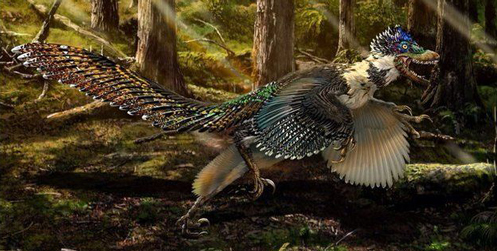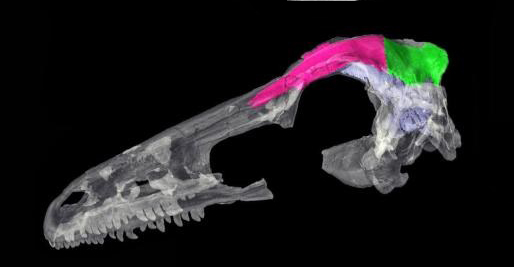Transforming Brains Require a Transforming Skull New Research Suggests
Bigger Brains of Birds Require Skull Modification
The dinosaur to bird transition involved significant change to the bones in the skull.
Most scientists agree that a group of dinosaurs, members of the Maniraptora clade, evolved into Aves. We now have two distinct parts to the Order Dinosauria, the extinct non-avian dinosaurs and their closely related, extant kin, the avian dinosaurs (birds). A lot of research has been undertaken in a bid to try to understand the evolutionary relationships between reptiles and birds. The lines between these two groups may be quite blurred, but ironically, although it is accepted that brain size and morphology changed as birds evolved and that the shape of the skull changed too, the specific relationship between regions of the brain and the bones making the skull roof has not been formally tested.
Dinosaur to Bird Transition
Step forward an international team of scientists, including researchers from Yale University and the Yale Peabody Museum of Natural History, they have concluded that the dramatic dinosaur to dino-bird to true bird transition was accompanied by profound changes in the bones that comprise the roof of the skull. Plotting the changes in skull bones in the fossil record can provide important insights into the way skulls develop over the Tetrapoda as a whole.
As Birds Evolved from Dinosaurs Skull Shape and Brain Size/Morphology Changed Dramatically

Very probably a ground-dwelling predator. A typical dromaeosaurid representing a stage on the dinosaur to bird transition.
Picture credit: Zhao Chuang
Tracking the Link Between Brain Development and Skull Roof Bones
The scientific paper, published in “Nature Ecology and Evolution” this week, represents the first time that scientists have mapped the link between skull bones and brain development.
Assistant Professor Bhart-Anjan Singh Bhullar, co-author of the paper commented:
“Across the dinosaur-bird transition, the skull transforms enormously and the brain enlarges. We were surprised that no one had directly addressed the idea that the underlying parts of the brain — the forebrain and midbrain — are correlated or somehow developmentally related to the overlying frontal and parietal bones.”
Graduate student, Matteo Fabbri, under the tutelage of Assistant Professor Bhart-Anjan Singh Bhullar at Yale University and the lead author of the scientific paper added:
“Our paper is a milestone in the way of approaching the morphological transition from reptile and dinosaur ancestors to extant birds.”
Looking at the Skull Roof of the Asian Troodontid Zanabazar (Z. junior)
Picture credit: Yale University
The picture shows a CT image (computerised tomography), of the skull roof of the Asian troodontid Zanabazar junior, a dinosaur that is closely related to extant birds. The frontal bone is highlighted in pink and the parietal is shown in green). The location of the brain is shown in the blueish/purple colour.
The Skull and the Brain Relationship in the Dinosaur to Bird Transition
Although previous studies had demonstrated a general relationship between the skull and brain development, associations between specific regions of the brain and individual bones that make up the skull roof had remained untested. This led to conflicting theories on some aspects of skull development within the Tetrapoda.
Assistant Professor Bhullar and his co-workers set out to trace the evolution of brain and skull shape not simply in those members of the Dinosauria closest to birds, but in the entire lineage leading from reptiles to birds. The team discovered that most reptile brains and skulls were very similar to each other. It was the dinosaurs most closely related to birds, as well as birds themselves, that were divergent, with enlarged brains and skulls ballooning out around them.
Identifying a Link Between Skull Bones and Brain Development
The researchers identified a clear link between the frontal bones and the forebrain and the parietal bones and the midbrain. This link was confirmed when the embryos of lizards, alligators and birds were examined using a new contrast-stained CT scanning methodology.
CT Scans of Various Tetrapod Skulls (Reptiles to Aves Link)
Picture credit: Yale University
The picture above shows three-dimensional, CT scans of four tetrapods that represent stages on the reptile to bird evolutionary line. The frontal bone is shown in pink, the parietal is depicted in green and the brain is once again shown as a blueish/purple object. A chicken skull (top), is compared to its close dinosaurian relative, the troodontid Zanabazar (second from top). A skull of the primitive, Late Triassic dinosaur* Herrerasaurus is shown below the skull of Zanabazar. At the bottom, is the skull of Proterosuchus, an Early Triassic archosauriform that is believed to be an ancestral form that diverged before the crocodile (Crurotarsi – crocodilians et al) and the bird (Ornithodira – dinosaurs, Pterosauria, Aves et al) split.
A Deep Developmental Relationship Between the Brain and the Skull Roof
Bhullar added:
“We suggest that this relationship is found across all vertebrates with bony skulls and indicates a deep developmental relationship between the brain and the skull roof. What this implies is that the brain produces molecular signals that instruct the skeleton to form around it, although we understand relatively little about the precise nature of that patterning. Ultimately, one of the important messages here is that evolution is simpler and more elegant than it seems. Multiple seemingly disparate changes — for instance to the brain and skull — could actually have one underlying cause and represent only a single, manifold transformation.”
*dinosaur Herrerasaurus – the exact phylogenetic relationship between the Herrerasauridae and the Dinosauria remains unclear. Herrerasaurids comprise of a group of archosaurs that show a number of dinosaurian and non-dinosaurian traits. In a recent (2017), revision of the Dinosauria, the Herrerasauridae was classed as a sister clade to the Sauropodomorpha and placed outside of the Ornithoscelida (theropods and ornithischians). Whether Herrerasaurus is a member of the Dinosauria remains open to debate.
Everything Dinosaur acknowledges the help of a press release from Yale University in the compilation of this article.
Visit the Everything Dinosaur website: Everything Dinosaur.



